Abstract
The eclogite-bearing Alag Khadny metamorphic complex in the Lake Zone, SW Mongolia occupies the central region of the Central Asian Orogenic Belt, the largest Phanerozoic orogenic belt in the world. The complex consists mainly of orthogneisses intercalated with eclogites and micaschists in a mélange zone. Most of eclogites are strongly amphibolitized. In this study, we examined petrography and mineral chemistry of eclogites and amphibolitized eclogites, respectively. The result of our research shows that Chandman eclogites experienced multiple events of metamorphism in throughout their subduction and subsequent collision history. We revealed that eclogites were subjected to blueschist facies metamorphism before the peak eclogite facies stage. In addition, we have studied amphibolitized eclogite, and revealed that another distinct progressive medium pressure (MP) epidote-amphibolite facies metamorphic event took place in the eclogite, consistent with collision process. The multiple events of metamorphism in eclogites have been revealed by zonation textures of HP amphiboles zoned with glaucophane→barroisite→Mg-hornblende and MP amphiboles zoned with actinolite/winchite→barroisite→Mg-hornblende/tschermakite/Fe-pargasite. These amphiboles with different zonation textures reflect their metamorphic history of subduction to collision events.
1. Introduction
Relics of subduction related high-pressure (HP) and relatively low-temperature (LT) rocks are common in orogenic belts. Reconstructing the geotectonic history of orogenic belts requires precise knowledge of pressure (P)—temperature (T)—time (t) paths for HP metamorphic rocks. These rocks are observed in suture zones that are often exposed after the collision related deformation, magmatism, and erosion processes. Relatively large slices of HP metamorphic rocks are interpreted to be exhumed through the subduction channel prior to being emplaced in the accretionary wedge. After the closure of a subducting slab, accretionary wedge formations often experience collision related Barrovian-type metamorphic environments. The mineralogical implication of this Barrovian-type metamorphism in the exhumed HP metamorphic rocks remains uncertain in many orogenic belts.
The exhumed HP metamorphic rocks are usually interpreted as following one or two P-T loop(s) in their metamorphic history. In the case of two P-T loops, the first loop indicated HP metamorphism whereas the second loop represents Barrovian type metamorphism. The single P-T loop have been identified in granulitized eclogites from the Ama Drime range, Eastern Himalayas [1], eclogites from Makbal district, N Tien-Shan [2], and Dabie-Sulu UHP rocks, Central China [3]. Two P-T loops have been unraveled in several orogenic belts—i.e, eclogites in Sambagawa belt [4], kyanite eclogite in Rhodope UHP complex, Pirin Mountains [5], and recently in HP metapelites Nevado-Filábride complex, Betic Cordillera [6].
The Central Asian Orogenic Belt (CAOB) includes a number of ophiolite blueschist, and eclogite-bearing metamorphic belts. These belts have been interpreted as related to the closure of the Paleoasian Ocean, e.g., [7,8,9,10]. HP blueschist and eclogite-blueschist complexes are mainly distributed in the west, northwest, and eastern parts of the CAOB [11]. Ages of these HP complexes vary from Neoproterozoic to Lower Paleozoic [11,12,13,14].
So far, only one occurrence of a high-pressure eclogite-bearing complex has been identified in the Chandman district, SW Mongolia [15,16]. This eclogite-bearing complex consist mainly of large bodies of mostly amphibolitized eclogite (up to 2 km long and 0.7 km width) with orthogneisess, micaschists, and serpentinite bodies, and is situated in the central part of the CAOB near the Zamtyn Nuruu and Dzavkhan-Baidrag basement blocks [17,18]. The peak metamorphic condition of the Chandman eclogites were estimated as 590–610 °C and 20–22.5 kbar [16], which corresponds to subduction type HP metamorphic conditions with lower geothermal gradient of 8 °C/km.
In this study, we examined petrography and mineral chemistry of eclogites and amphibolitized eclogites. Our work presents the first account of blueschist to eclogite facies metamorphic events related to subduction processes followed by amphibolitization by collision. Evidence for these processes have been revealed by textures and mineralogical studies of amphiboles. We propose that once subduction related metamorphism ended, the eclogites were juxtaposed and metamorphosed with surrounding country rocks during the collision.
2. Geology
Mongolia is composed of a number of tectonic zones situated within the Central Asian Orogenic Belt (CAOB) [7,8,9] or the Altaids [19,20]. The CAOB developed among the Siberian craton in the north, the Tarim craton in the southwest, and the North China craton in the south [8] (Figure 1a). The tectonic evolution of the CAOB suggests that it probably represents a long-lived accretionary complex related to subduction of the North China oceanic plate beneath the Siberian craton, closure of the Palaeo-Asian ocean between the continents, and final collision of the Tarim and North China cratons during the Permian [21,22,23,24]. Mongolia is traditionally subdivided into northern and southern tectonic domains. These domains are separated by a major fault, the Main Mongolian lineament (MML). The MML is a regional structural boundary separating mainly Precambrian and Lower Paleozoic rocks in the north from Middle to Upper Paleozoic rocks in the south [25] (Figure 1b). The western part of the northern domain contains a roughly 1000 km long island arc terrane known as the Lake Zone. The Lake Zone is composed of slightly metamorphosed volcano-sedimentary sequences of Proterozoic to Lower Palaeozoic ages, which alternate in tectonic mosaic with highly metamorphosed rocks (such as eclogite) with ophiolites associated with the Dzabkhan-Baydrag basement block [25].
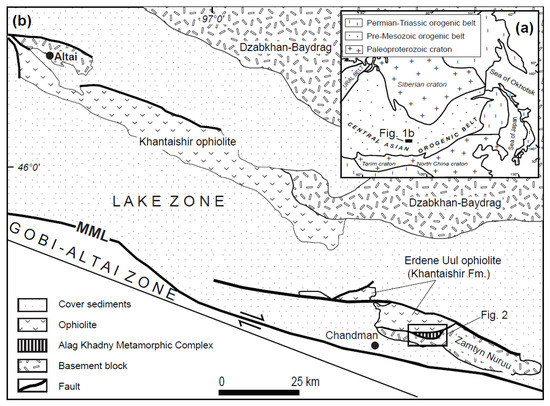
Figure 1.
(a) Simplified tectonic map of the Central Asian Orogenic Belt and adjacent cratons (modified after Jahn et al. [8]); (b) Simplified tectonic sketch map of the Lake Zone (modified after Javkhlan et al. [28]).
The Chandman district, located in the southeast part of the Lake Zone, is composed of four major geologic units (Figure 1b). Neoproterozoic ophiolites of the Khantaishir Formation (Erdene Uul ophiolite) [26] occur in the north. High-pressure metamorphic rocks including eclogites of the Alag Khadny Metamorphic Complex are interleaving with Maykhan Tsakhir Formation marbles in the central part of the district and both units are interpreted as a tectonic mélange [15]. The Maykhan Tsakhir Formation is considered as former passive margin sediment [26,27] and contains lenses of garnet-chloritoid schists located close to the contact with the eclogite body [28]. The Zamtyn Nuruu Formation crop out in the south has been interpreted as a basement block consists mainly of migmatized orthogneiss, amphibolites, metagabbro, and paragneiss [17]. Contacts of all these units are tectonic or tectonized [15]. The Zamtyn Nuruu Formation is overthrusted by both the Alag Khadny Metamorphic Complex and the Maykhan Tsakhir Formation, which themselves are overthrusted by the Khantaishir Formation (Erdene Uul ophiolite) [15,26].
The Alag Khadny metamorphic complex consists of eclogites, orthogneisses, various types of micaschists and ultramafic serpentinite bodies, exposed in a belt extending between the Mt. Ulaan Tsakhir and Mt. Alag Khad (Figure 2). Most of bodies of eclogite are strongly amphibolitized. However, fresh massive eclogites are commonly preserved in the interiors of the amphibolitized eclogitic bodies. Buriánek et al. [26] obtained U-Pb zircon ages of c. 950 Ma from the core and c. 540 Ma from the rim of zircons in the orthogneiss close to eclogite interpreted as a timing of magmatic and metamorphic events, respectively.
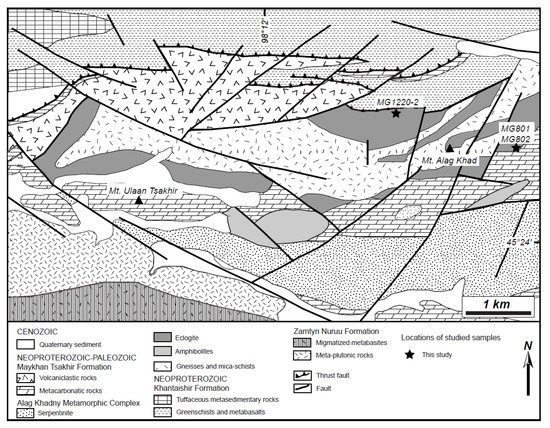
Figure 2.
Geological map of the Chandman district, Lake Zone, SW Mongolia (modified after Hanžl & Aichler [15]). Field localities of samples collected from Alag Khadny metamorphic complex.
3. Petrography and Mineral Chemistry
Fresh eclogites (MG801, MG802) (Figure 3d) and amphibolitized eclogite (MG1220-2) (Figure 3e) were collected close to Mt. Alag Khad (Figure 2). Photomicrographs of thin sections and backscattered electron images (BEI) of the eclogites and amphibolitized eclogite are shown in Figure 3d,e, Figure 4, and Figure 5. Representative electron microprobe analyses of minerals in the rocks are given in Table 1 (garnet), Table 2, Table 3 and Table 4 (other minerals in the eclogite and amphibolitized eclogite). Chemical compositions of minerals were measured using electron probe microanalysers (JEOL JXA-8800M and JXA-8530F) installed at the Department of Geoscience, Shimane University, Japan. The analytical conditions used for all minerals were 15 kV accelerating voltage, 20 nA beam current and 3–5 μm beam diameter. Corrections were carried out using the procedures of Bence & Albee [29]. Ferric iron contents in garnet and clinopyroxene were estimated on the basis of charge balance ((Fe3+ = 8 − 2Si − 2Ti − Al (for garnet); (Fe3+ = 4 − 2Si − 2Ti – Al + Na (for clinopyroxene)). Jadeite and aegirine contents (mol %) in clinopyroxene were estimated as Jd = AlVI × 100. Fe3+ in amphibole was estimated as total cations 13 = Si + Al + Ti + Cr + Mg + Fe + Mn {(for O = 23; 13eCNK method described by Schumacher, in Leake et al. [30]}.
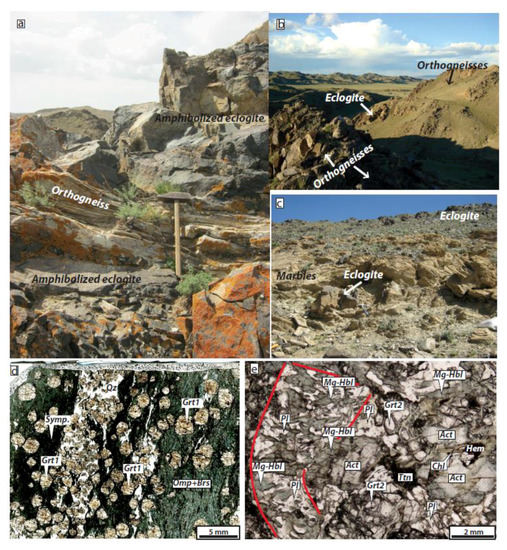
Figure 3.
view of the outcrops in the Chandman district. (a) Orthogneiss interleaved with amphibolitized eclogite body (MG1220-1); (b) the orthogneiss surrounding eclogite body and (c) small lens of eclogite body enclosed in the marble; (d) Photomicrograph of the relatively fresh glaucophane-bearing eclogite (MG802) consists mainly of garnet (Grt1), omphacite, and barroisite. Compositionally different layers developed along the schistosity in the eclogite sample as composed of quartz-rich and quartz poor mafic layers; (e) Photomicrograph of the amphibolitized eclogites consist mainly of amphiboles (actinolite, Mg-hornblende), plagioclase, and garnet. Red lines indicate boundary zone of symplectitic assemblage consisting intergrowth of plagioclase and Mg-hornblende. Larger amphiboles have zoning with paler colored cores with greenish colored rims. Abbreviations: Symp, symplectite; Grt1, garnet1; Grt2, garnet2; Omp, omphacite; Brs, barroisite; Qz, quartz; Mg-Hbl, Mg-hornblende; Pl, plagioclase; Act, actinolite; Ttn, titanite; Hem, hematite.

Figure 4.
and backscattered electron image (BEI) images of eclogites from the Alag Khadny metamorphic complex. (a) Photomicrograph of eclogite (MG802). Mineral assemblage of garnet (Grt1), omphacite (Cpx2) barroisite (Amp2) and rutile in the matrix. Omphacties replaced by symplectite of plagioclase, clinopyroxene (Cpx3) and Mg-hornblende (Amp3). Garnet included polyphase and single grain inclusions of omphacite (Cpx1) and amphibole (Amp1). Open nicol; (b) The porphyroblastic garnet (Grt1) includes polyphase inclusion of barroisite (Amp1)+rutile and single grain inclusions of taramite (Amp1), epidote (Ep), albite (Ab), omphacite (Cpx2), and quartz (BEI; MG802); (c) BEI image shown coexisting assemblage of garnet (Grt1), omphacite (Cpx2), barroisite (Amp2). Fine grains of plagioclase (An < 6) were formed later between the Amp2 and Cpx2; (d) BEI shown the enlarged photo of barroisitic Amp2. Amp2 have a prograde (relicts of glaucophane core with barroisite mantle) and retrograde (barroisite mantle with Mg-hornblende rim) zoning; (e) Mineral assemblage of garnet (Grt1), omphacite (Cpx2), and phengite (Ph). Omphacite replaced by symplectite of clinopyroxene (Cpx3), Mg-hornblende (Amp3), and plagioclase (Pl2). Phengite replaced by biotite (Bt2) and plagioclase (Pl3) symplectite (BEI; MG801); (f) Chemically zoned omphacite (Cpx2) with core (Jd27) and rim (Jd36) surrounded by barroisite (Amp2). The matrix omphacite (Cpx2) is moderately fractured and fracture filled by the later stage Mg-hornblende (Amp3). Abbreviations: An, anorthite; Rt, rutile; Chl, chlorite; Jd, jadeite component.
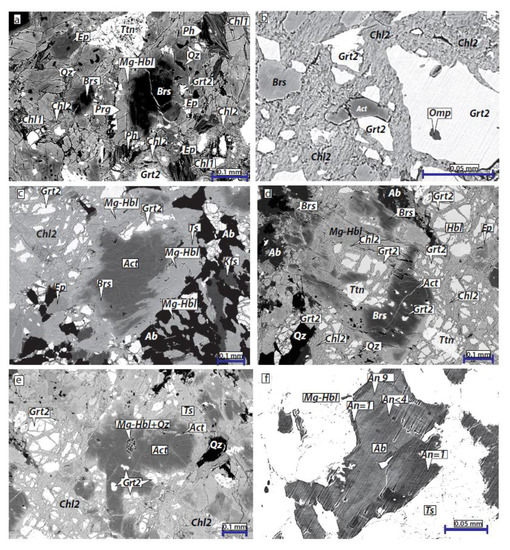
Figure 5.
images from the amphibolitized eclogite (MG1220-2). (a) A large grain zoned amphibole coexist with phengite (Ph), chlorite (Chl1), epidote (Ep), and titanite (Ttn). Amphibole have a core of barroisite with overgrown rim zoned with Mg-hornblende and pargasite. Relics of fragmental garnets (Grt2), amphibole and darker flakes of Chl1 are surrounded by fine-grained aggregates of chlorite (Chl2); (b) Fragmental garnet (Grt2), barroisite, actinolite are surrounded by Chl2. Grt2 contain inclusion of omphacite (Cpx1); (c) Resorbed core zoned with actinolite to barroisite overgrown by Mg-hornblende and tschermakite (Ts). Discrete anhedral and subhedral smaller Mg-hornblende are forming symplectite texture together with plagioclase and K-feldspar; (d) Partially resorbed core of amphibole contains inclusions of fragmental garnet (Grt2). During the resorbtion Chl2 surround the amphibole and infiltrated into the core of amphibole and partially replaced inclusions of Grt2. Amphibole zoned as barroisite resorbed core with Mg-hornblende rim. Albite (Ab), epidote, and quartz coexist with Mg-hornblende. Thin actinolite micro-vein cross cut zoned amphibole; (e) Fragmental garnet (Grt2) strongly replaced by Chl2. Core of actinolite contain symplectitic polyphase inclusion of Mg-hornblende and quartz, probably indicating former omphacite; (f) Symplectitic plagioclase have a zoning with anorthite content increase from the core (An = 4) to the mantle (An = 9) and decrease from the mantle to the rim (An = 1).

Table 1.
Chemical compositions of garnets from the eclogites and amphibolitized eclogite.

Table 2.
Representative chemical compositions of clinopyroxenes from the eclogites and amphibolitized eclogite.

Table 3.
chemical compositions of amphiboles from the eclogites and amphibolitized eclogite.

Table 4.
chemical compositions of phengite, paragonite, chlorite, and biotite from the eclogites and amphibolitized eclogite.
3.1. Eclogite
Eclogite is medium-to-fine grained, consisting mainly of reddish garnet, pale green clinopyroxene (mostly omphacite), and dark-green barroisite with subordinate amounts of epidote, phengite, paragonite, plagioclase, biotite, chlorite, K-feldspar, rutile, titanite, quartz, calcite, hematite, and zircon. Barroisite- or tremolite-rich veins (up to 0.3–5 mm in width) which occur parallel or subparallel to the schistosity [31], and also micro-veins of prehnite-quartz, calcite, and actinolite are developed in the eclogites.
Porphyroblastic garnet (Grt1) is set in a fine-grained matrix of barroisite and omphacite (Figure 3d and Figure 4a). Strain shadows formed on both sides of the Grt1, often filled by barroisite (Figure 4a). A schistosity (Se) is defined by preferred orientation of nematoblastic short prismatic crystals of barroisite and omphacite (sample MG802; Figure 3d and Figure 4a). Secondary fine-grained (<0.02 mm) symplectitic assemblage of plagioclase (Pl; anorthite component (An) = 1–13) + Mg-hornblende ± clinopyroxene ± epidote after omphacite which often have a lobate vermicular form crystallized between the barroisite and omphacite (Figure 4c,d). Phengite (Si = 6.50–7.12 pfu) is crystallized together with garnet and omphacite (Sample MG801; Figure 4e). The rim of the phengite decomposed into symplectite assemblage of plagioclase (An = 2–18) and biotite (XMg {Mg/(Mg + Fe)} = 0.41–0.62; Figure 4e).
3.1.1. Garnet
Most of Grt1porphyroblastic garnet in the eclogites is euhedral to subhedral grains with sizes up to 2 mm across. Fractures of the garnet are filled by albite (An = 1–5), K-feldspar, epidote, and chlorite (XMg {Mg/(Mg + Fe)} = 0.52 – 0.54). Garnet shows inclusion-rich cores and inclusion-poor rims (Figure 4a). The core part of the garnet contains inclusions of taramite, Fe-barroisite, pargasite, Fe-pargasite (Amp1), chlorite (XMg = 0.36–0.38), epidote (Xps{Fe3+/(Al + Fe3+)} = 0.16–0.31), albite (An2–5), biotite (XMg = 0.52–0.58), rutile, titanite, calcite, and quartz. While, the rim part of the garnet contains inclusions of barroisite (Amp1), omphacite (Cpx1; Jd < 39), rutile, taramite, phengite (Si = 6.62–6.74 pfu), epidote, titanite, and quartz (Figure 4b). The alignment of inclusions in the porphyroblastic garnet (Si) is oblique to Se (Figure 4a). The composition of garnet (Table 1) is pyralspite type (Alm57−64, Grs23−32, Prp5−15, Sps < 10). The compositional profile in the individual grain (Figure 6a,d) has prograde zoning of XMn decreasing from core to rim, whereas the XMg increases antipathetically. XCa is relatively homogeneous in the core and slightly increases to the rim, but when XMg is increases to the rim XCa decrease. XFe is relatively homogeneous; and slightly decreases to the rim (Figure 6a).
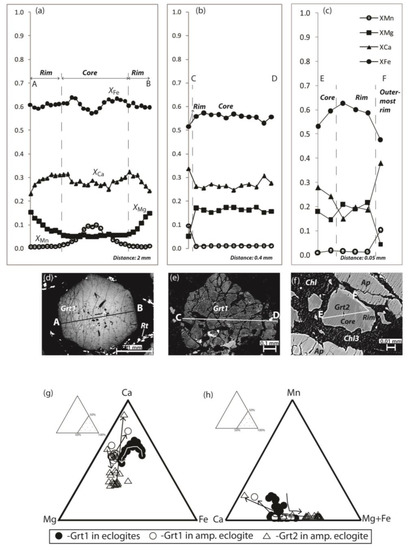
Figure 6.
zoning patterns of garnets. Zoning patterns (rim-rim) of Grt1 from eclogites (a), amphibolitized eclogite (b), and zoning pattern of Grt2 (c) shown. (d) A,B analysis line on the Grt1 of eclogite. Result of analysis is shown in Figure 6a. (e) C,D analysis line on the garnet of amphibolitized eclogite. Result of analysis is shown in Figure 6b. Garnet (Grt1) from the amphibolitized eclogites is mainly homogeneous in composition except in outermost rim with high Mn content. (f) E,F analysis line on the garnet (Grt2) of amphibolitized eclogites. Result of analysis is shown in Figure 6c; (g) Ca−Mg−Fe chemical diagram for garnets of eclogites and amphibolitized eclogites. White arrow indicates from core to rim of garnet in the eclogite. Black arrow indicates from core to rim of Grt2 in the amphibolitized eclogites. (h) Mn−Ca−Mg + Fe chemical diagram for garnets of eclogites and amphibolitized eclogites. Arrows indicate from core to rim of garnet in the eclogites and amphibolitized eclogites.
3.1.2. Clinopyroxene
The jadeite component (Jd) of Cpx1 varies from 24% to 39%. Discrete grains of omphacite (Cpx2) occur as euhedral to subhedral prismatic crystals, up to 1 mm long in the matrix (Figure 4c–f). Cpx2 (Jd27–46) contains inclusions of quartz, epidote, and rutile. Some of Cpx2 are surrounded by smaller grains of barrosite (Figure 4f). Cpx2 is mainly homogeneous in composition. However, some of Cpx2 rarely show a chemical zoning with low-jadeite core (Jd27) and higher-jadeite rim (Jd36) (Figure 4f). Symplectitic clinopyroxenes (Cpx3) are classified mainly as diopside and rarely as aegirine-augite and omphacite composition. Jadeite component of Cpx3 is up to 25% and aegirine component is up to 15% (Figure 7a, Table 2).
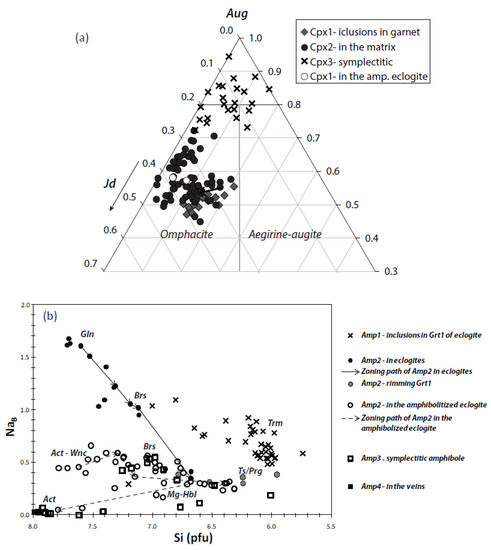
Figure 7.
(a) Chemical composition of clinopyroxene from eclogites and amphibolitized eclogite; (b) Chemical composition of amphiboles from eclogites and amphibolitized eclogite.
3.1.3. Amphibole
Amphibole (Amp1) inclusions in Grt1 form mostly small euhedral to subhedral crystals corresponding to sodic-calcic (mainly of taramite few of Mg-taramite, Fe-barroisite, barroisite) and minor calcic amphiboles (Fe-pargasite, pargasite, Mg-hornblende; Figure 4a,b; Table 3), with relatively lower Si content and lower NaB than Amp2 (Figure 7b). Amp1 also shows high-TiO2 content (up to 1.56 wt %).
Discrete grains of barroisite (Amp2) at a distance from the garnet contacts in the matrix form subhedral, prismatic crystals, with pleochroic with x’ = pale green and z’ = pale bluish green. Locally, relicts of glaucophane are preserved in the core of the Amp2 (Figure 4c,d) indicate they were replaced by barroisitic amphibole (Amp2) during the crystallization of omphacite. Rims of barroisitic amphibole itself are Mg-hornblende in compositions. Some of Amp2 contact with garnet (Figure 4b) is Fe-pargasite, locally Mg-hornblende in compositions (Figure 7b).
Symplectitic amphibole (Amp3) is a fine grained (~0.03 mm), and they are mainly with Mg-hornblende, rarely actinolite in composition.
3.1.4. Other Minerals
Paragonite occurs as inclusion in the garnet in the eclogites and it is anhedral grain, and up to 0.02 mm across. K-feldspars in the eclogites occur locally as constituent of symplectite after omphacite. Rutile occurs together with garnet, omphacite, and barroisite in the matrix (Figure 4a,f). Titanite occurs in the matrix, usually replacing rutile.
3.2. Amphibolitized Eclogite
The amphibolitized eclogite is fine grained, consists mainly of dark-green amphiboles (actinolite, Mg-hornblende, Fe-pargasite, and tschermakite), plagioclase, with minor amounts of garnet, epidote, chlorite, phengite, K-feldspar, rutile, titanite, quartz, apatite, hematite, and zircon (Figure 3e). Micro amphibole veins (<0.05 mm) are locally cross-cut the schistosity. Compared to fresh eclogite, minerals of amphibolitized eclogite are randomly oriented and granoblastic. The original high-pressure, plagioclase-free assemblage of garnet + omphacite was overprinted during the post-eclogite facies development of lower pressure assemblage of Mg-hornblende + plagioclase + epidote + chlorite + phengite + titanite (Figure 3e and Figure 5a–f). Omphacite has not been observed in the matrix of the amphibolitized eclogite, except only two grains of omphacite (Jd34–38; Cpx1) survived as an inclusion in the garnet (Grt2; Figure 5b). The matrix is characterized by a symplectitic mineral assemblage sized up to 0.2 mm, consisting mainly of vermicular plagioclase, Mg-hornblende, minor K-feldspar and epidote (Figure 3e and Figure 5c). Moreover, larger grains of zoned amphibole are grown together with titanite, flakes of chlorite (Chl1; XMg = 0.43–0.45) and phengite (Figure 3e and Figure 5a) in the symplectite-poor part of the matrix. Former eclogitic garnets are strongly fragmented into aggregates, surrounded by fine-grained chlorite (Chl2; Figure 5b–e). Some of cores of large grain of amphibole contain those of aggregates of garnet (Grt2) and symplectitic aggregate of Mg-hornblende and quartz probably after omphacite (Figure 5d,e) as inclusion. These textures suggest the core of amphibole (Amp2) in the amphibolitized eclogites grew after the decompression stage of the HP eclogitic event. Inclusion of garnets itself is replaced by Chl2 within amphibole (Figure 5d). Few of relatively large up to 0.7 mm in size porphyroblastic garnet (Grt1; Figure 6e) are observed in the matrix.
3.2.1. Garnet
Grt1 is euhedral to subhedral and strongly fractured (Figure 6e). Grt2 is mostly fragmented aggregates, up to 0.2 mm across (Figure 5a–e). Grt1 and Grt2 are pyralspite type (Alm48–68, Grs14–38, Prp4–25, Sps < 14) (Table 1). Grt1 in the amphibolitized eclogites (Figure 6e) has a zoning that also all of XMn, XMg, XCa, and XFe are relatively homogenous in the core part. Whereas, XMn and XCa are increase sharply to the outermost rim, in contrast, XMg and XFe decrease sharply and moderately, respectively to the outermost rim part of Grt1 (Figure 6b). The core of Grt1 in the amphibolitized eclogites (XMg (0.15–0.17), XCa (0.25–0.30)) is compositionally similar to the rim of Grt1 in the eclogites (XMg (0.05–0.15) and XCa (0.23–0.30)) (Figure 6g,h). Grt2 in the amphibolitized eclogites is mainly in homogenous composition. However, some of fragments (Figure 6f) show zoning of XCa- and XMn-rich outermost rim (Figure 6c,f). Grt2 is relatively lower in XCa, higher in XMg and XFe than Grt1 in the amphibolitized eclogite (Figure 6g).
3.2.2. Amphibole
Large grained zoned amphibole is randomly oriented, occurs as euhedral to subhedral grains up to 1 mm long, and pleochroic zoning with x‘ = pale yellowish green and z’ = pale bluish green in the core with resorbed texture and x’ = green and z’ = deep green in the rim (Figure 3e and Figure 5a–e). Amphiboles in the amphibolitized eclogite are classified into sodic-calcic and calcic groups and have a chemical zoning with partially resorbed core with actinolite, winchite, and barroisite in compositions with overlapping Mg-hornblende and tschermakite, Fe-pargasite rim (Figure 8; Table 3). Thin micro-vein cross-cut large grained amphibole is actinolite in composition (Figure 7b).
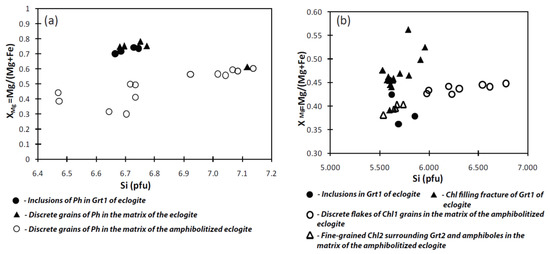
Figure 8.
(a) Chemical composition of phengite from eclogites and amphibolitized eclogite. (b) Chemical composition of chlorite from eclogites and amphibolitized eclogite.
3.2.3. Other Minerals
Plagioclases in the amphibolitized eclogite occur as anhedral and up to 0.2 mm across. Plagioclases are mainly albite in composition and shows zonation with core (An 4–5), mantle (An < 9) and rim (An1) (Figure 5f). Phengite (Si = 6.47–6.73 pfu) in the amphibolitized eclogite is euhedral to subhedral and it is up to 0.07 mm across (Figure 5a). XMg ratio of phengite (0.30–0.60) in the amphibolitized eclogite is lower than phengite in the eclogite (XMg = 0.61–0.78; Figure 8a). Epidote (Xps = 0.14–0.21) as discrete grain in the matrix of the amphibolitized eclogite is subhedral and up to 0.05 mm across (Figure 5a,c). Rutile is surrounded by titanite. Chl2 has XMg varies from 0.38 to 0.43, lower in Si content (5.54–5.74 pfu) than flakes of Chl1 (Si = 6.00–6.77) in the matrix of amphibolitized eclogite (Figure 8b).
4. Discussion
4.1. Metamorphic Evolution of Chandman Eclogite and Amphibolitized Eclogite
Petrographic textural relationships and mineral assemblages suggest multiple cycles of progressive metamorphism or events (HP and MP) proposed for the Chandman eclogites. This evolution is expressed by two types of zonation in HP and MP amphiboles of eclogites—i.e., glaucophane→barroisite→Mg-hornblende (Amp2 coexisting with omphacite formed in HP event) and actinolite/winchite→barroisite→Mg-hornblende/tschermakite/Fe-pargasite (Amp2 coexisting with plagioclase and epidote formed in MP event). The first HP event is characterized as typical high-pressure metamorphism with the formation of an eclogite lithology. In this event, eclogites experienced multiple stages, i.e., precursor, prograde blueschist facies, peak eclogite facies, and decompression amphibolite facies stages (Figure 9). The second MP event is divided into two stages, i.e., prograde to peak stage (epidote-amphibolite facies) and retrograde (greenschist facies) stage (Figure 10).

Figure 9.
paragenesis of eclogites. ECL, eclogite facies; BS, blueschist facies; AMP, amphibolite facies; GS, greenschist facies.
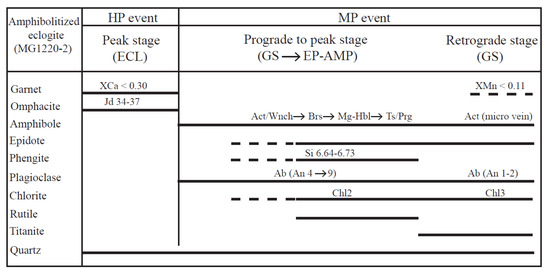
Figure 10.
paragenesis of the amphibolitized eclogite.ECL, eclogite facies; EA-AMP, epidote-amphibolite facies; GS, greenschist facies.
4.1.1. HP Metamorphic Event
Precursor Stage
The precursor stage is characterized by inclusions of Amp1 (taramite, Mg-taramite, Fe-pargasite) with high-TiO2 (<1.56 wt %), albite, biotite, chlorite, and epidote in the garnets. Inclusions of chlorite, albite, epidote, and calcite suggest they were stable at greenschist facies conditions (Figure 11). Similar inclusions of taramite, Fe-pargasite together with biotite from the eclogite in North Tianshan may indicate amphibolites facies was achieved [2,32]. Faryad and Bernhardt [33] described equilibrium assemblage of taramite and pargasite together with albite, chlorite, epidote, biotite, garnet developed in the metabasites from Rakovec Group is formed by higher P/T part of greenschist facies (380–440 °C and 6–8 kbar) metamorphism. The appearance of taramite, Mg-taramite described that they were replacing magmatic pyroxene favored by introduction of Na from magmatic plagioclase and formation of Ca-rich garnet formed by local equilibrium of magmatic plagioclase replacement [33]. Such Na content in the protolith of eclogite also can be related with hydrothermal alteration of protholith by mid-oceanic ridge metamorphism or E-MORB protolith composition of Chandman eclogite itself [34]. The oceanic water infiltration into the newly formed young and hot basaltic protolith may be causing of local scale metasomatism, and sodic-calcic taramites and calcic Fe-pargasites were probably formed in the dehydrated protolith during initiation of subduction.
Prograde to Peak Stage
The prograde blueschist facies stage of HP event for eclogites first time obtained by the evidence of relic zoning texture of eclogitic amphibole which shows relict glaucophane with barroisite mantles (Figure 4c,d). Unfortunately, we cannot determine, which of the above described inclusion minerals in the eclogitic garnet is coexisting with glaucophane. Instead of lawsonite, only epidote inclusions are observed, therefore we assume that eclogites may have traversed epidote-blueshicst facies conditions. Although, glaucophane can be stable under eclogite facies conditions [35,36] but texture of zoning of amphibole in eclogite indicates glaucophane was once formed and consumed before the peak assemblage developed. Omphacite and garnet assemblage were developed at the expense of glaucophane. Relicts of glaucophane in barroisite coexist with omphacite indicates conditions of glaucophane stability [37] in the epidote blueschist facies (Figure 11). The presence of inclusions of epidote in the rim of Grt1 suggests that epidote is probably stable in the prograde stage of blueschist to eclogite facies conditions instead of lawsonites.
The peak mineral assemblage of eclogite facies is defined by the rim of the Grt1 (XMg < 0.19; XMn~0.01), omphacite (Cpx2; Jd < 46), barroisite (Amp2), phengite (Ph2; Si < 6.96 pfu), quartz and rutile in the eclogites (Figure 9). THERMOCALC program (Version 3.33, ritten by Roger Powell, the University of Melbourne, Parkville, Australia) with an updated internally consistent thermodynamic data set [38,39] was used to apply an “average PT” mode calculation for the mineral assemblages that estimated P-T conditions. The activities of the minerals were calculated using the AX program (written by Tim Holland, University of Cambridge, Cambridge, UK) [39]. End-members with very low activities (<0.0001) were excluded from the calculation. If fit indices exceeded the value allowable for 95% confidence in the P-T result, then the most suspect activity (largest e*) was removed and the calculation was re-run [40]. The activity of H2O is assumed to be unity. Quartz and H2O are present in the assemblage.THERMOCALCcalculations for the peak stage applied for the assemblage of Grt + Omp + Brs ± Ph in eclogites yielded P-T conditions of 520–570 °C (±37–43 °C) and 22–24 kbar (± 1.5–1.7 kbar; sigfit = 0.21–0.97) (Figure 11, Table 5). Garnet (Grt2) in the amphibolitized eclogites contains inclusions of omphacite in the amphibolitized eclogite. Chemical compositions of the cores of Grt1 and Grt2 are similar to rims of Grt1 in eclogites and evidence of omphacite inclusion suggests that amphibolitized eclogite is preserved in HP eclogite facies metamorphism. However, the KD value estimated for only two omphacite inclusions in the garnet and value vary from KD11 to KD12 which temperature gives 600–610 °C at 20 kbar. The P-T path from prograde to peak stage shown a relatively low geothermal gradient (Figure 11).

Table 5.
Representative THERMOCALC calculations for peak stages for HP and MP events
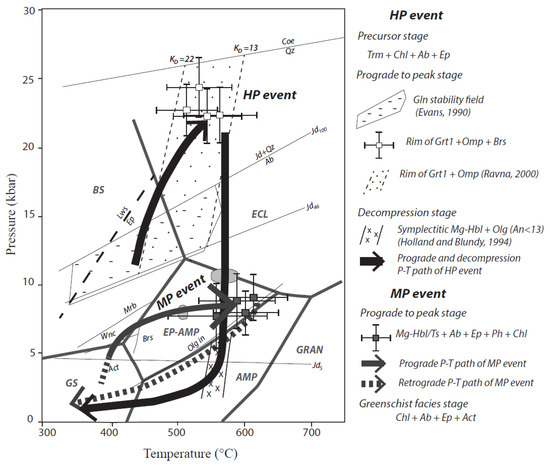
Figure 11.
Estimated P-T conditions for eclogites and the amphibolitized eclogite of Alag Khadny metamorphic complex. ECL, eclogite facies; BS, blueschist facies; EA-AMP, epidote-amphibolite facies; AMP, amphibolite facies; GS, greenschist facies; GRAN, granulite facies. Dotted field of P-T conditions is represented by the KD [(Fe2+/Mg)Grt/(Fe2+/Mg)Cpx] values of garnet-clinopyroxene pairs and maximum Jd content in omphacite without coesite estimated by thermobarometer. Thin lines show the stability fields of actinolite (Act), winchite (Wnc), magnesioribeckite (Mrb), and barroisite (Brs) and the thick dashed line is the boundary of lawsonite–blueschist and epidote–blueschist [37]. Ellipsoid gray colored polygon is P-T conditions of prograde and peak metamorphic stage of garnet-chloritoid schist [28].
Decompression Stage (HP)
Symplectite of plagioclase (Pl2; An1–13) + Mg-hornblende (Amp3) + clinopyroxene (Cpx3; Jd = 2–25) ± epidote (Ep3) after omphacite (Cpx2) and plagioclase (An = 2–18) + biotite assemblage after phengite suggest the decompression stage passed from the eclogite facies to the amphibolites facies (Figure 11). Plagioclase (An = 1–13) + Mg-hornblende assemblage gives 530–580 °C using thermometer of Holland & Blundy [41] and the upper limit of pressure is restricted by oligoclase-in line [42] (Figure 11) and the pressure is estimated as 2–6 kbar using calcic-amphibole barometer of Brown [43]. Low jadeite component (Jd = 5) of Cpx3 gives ~4 kbar [44] well correlated with the results of the pressure estimation for symplectitic Mg-hornblende (Amp3). The decompression P-T path of Chandman eclogites is nearly isothermal (Figure 11) and suggests that it is comparable with “Alpine-type” subduction [45]. The HP minerals (Grt, Omp, Brs, and Ph) in eclogites are well preserved and suggest a fast exhumation under relatively low temperature [46,47].
4.1.2. MP Metamorphic Event
Chemical zonings of amphibole in the matrix (Amp2; Act/Wnc→Brs→Mg-Hbl/Ts/Fe-Prg) and plagioclase (Pl5; An4→An9) in the amphibolitized eclogite have a prograde zoning. The core of amphibole (Amp2) contains inclusions of fragmental garnet (Grt2) (Figure 5d) and symplectitic aggregate of Mg-hornblende and quartz probably after omphacite (Figure 5e). These textures suggest the core of amphibole (Amp2) in the amphibolitized eclogites grew after the decompression stage of the HP eclogitic event. These textures and chemical zoning of Amp2 suggest eclogites experienced another distinct metamorphic event (MP).
Prograde to Peak Stage (MP)
The prograde stage of the MP event is characterized by the partially resorbed core zoned with Act/Wnc→Brs of the Amp2 in the amphibolitized eclogite. The P-T path of prograde stage of the MP event of the amphibolitized eclogite passed through actinolite and barroisite stability fields (Figure 11) [48].
The rim of Amp2 has a prograde zoning of Mg-hornblende to tschermakite and Fe-pargasite and they coexist with albite (An < 9), epidote, chlorite (Chl1), K-feldspar,and phengite. The coexisting assemblage in the amphibolitized eclogites suggests high-pressure intermediate conditions of epidote-amphibolite facies. The peak P-T conditions for the MP metamorphic event were estimated by Mg-hornblende-albite and tschermakite/Fe-pargasite-albite pairs yields similar temperature conditions of 530–590 °C using the thermometer of [41]. The lower limit of peak pressure conditions of MP event was estimated by Si content (6.6 pfu) of phengite (Ph2) [49]. THERMOCALC calculations for the peak stage (MP) applied for the assemblage of Mg-Hbl/Ts/Fe-Prg + Ep + Ph + Chl1 + Pl (An6–9) in the amphibolitized eclogite yielded P-T conditions of 550–610 °C (±48 to 74 °C) and 7–9 kbar (±1.6–2.4 kbar) (sigfit = 0.93–1.70) (Figure 11) (Table 5) fall into the epidote-amphibolite facies field close to the boundary of the upper portions of amphibolites facies field.
The distinguished MP event in amphibolitized eclogite is probably related with a collisional event [50] with emplacement of granitic magmatism and their subsequent metamorphism (orthogneiss formation). Javkhlan et al. [28] suggested collisional metamorphism for garnet-chloritoid schists in the marbles of Maykhan Tsakhir Formation that are distributed close to the eclogite bodies in the Chandman district. The P-T path of pre-peak (500–510 °C; P = 7–8 kbar) and peak (560–590 °C; 10–11 kbar) stages of garnet-chloritoid schist characterize a Barrovian type metamorphism. The geothermal gradient of MP event of amphibolitized eclogite (550–610 °C and 7–9 kbar) is comparable with the geothermal gradient of garnet-chloritoid schist.
Retrograde Stage of Greenschist Facies (MP)
Garnets of eclogite are partly replaced by chlorite, albite (An1–2), and epidote along their cracks in the eclogite. In the amphibolitized eclogite, porphyroblastic, and fragmental garnets (Grt1 and Grt2, respectively), amphiboles (Amp2) and epidotes in the amphibolitized eclogite are strongly replaced by chlorite (Chl2), and rims of plagioclase (An4–9) are albite (An~1) in compositions (Figure 5). Although, outermost rims of porphyroblastic Grt1 and fragmental Grt2 are Mn-rich (XMn~0.10) in compositions. These textures suggest they were formed during the retrograde metamorphism of the greenschist facies conditions after MP event (Figure 11).
4.2. Tectonic Implication of Chandman Eclogites
The presence of relic glaucophane in the Chandman eclogite indicates they have been subjected to blueschist facies conditions and also indicates a protolith of “cold” and “old” mature oceanic lithosphere [51] existed prior the initiation of subduction. Buriánek et al. [26] proposed that protholith of eclogites derived from Khantaishir-Erdene Uul ophiolite, dated as c. 970 Ma and it (protolith of eclogite) is part of the ancient Mirovoi ocean at passive margin side of Baydrag-Zamtyn nuruu continent. Skuzovatov et al. [34] and suggested that the protolith of eclogite originated by rifting of the Rodina continent (Rodina break-up) during the Early Neoproteroizoic. In both scenarios, existence of Neoproterozoic “cold and old” ocean was developed and it did cool sufficiently to allow the oceanic lithosphere to subducted [52].
Direct age dating on eclogites has been limited to only 40Ar/39Ar and K-Ar methods so far. K-Ar ages (amphibole and phengite) of amphibole-rich veins developed in the eclogite bodies (c. 600 Ma) [31], and 40Ar/39Ar phengite ages of eclogite and garnet-chloritoid schist (c. 540 Ma) within marbles of the Maykhan Tsakhir Formation [16] have been applied. These ages indicate a cooling or exhumation ages after their peak P-T conditions were attained. Javkhlan et al. [31] explained their obtained much older age (c. 600 Ma) by two different exhumation histories of the eclogites, if the influence of “excess Ar” is negligible. This argument corresponds with our present results. We argue that older c. 600 Ma age for eclogites probably represent a cooling age of the HP subduction event. Whereas younger c. 540 Ma ages for both eclogites and garnet-chloritoid schists are probably represent a cooling age of MP collision event of metamorphism since the peak P-T conditions of MP event of eclogite (550–610 °C and 7–9 kbar) and garnet-chloritoid schist (560–590 °C; 10–11 kbar) [28] are comparable. It is possible that during the MP event, component of Ar in the phengite of eclogite close to garnet-chloritoid schist were re-equilibrated.
Hrdličková et al. [53] predicted possible collision of Dzabkhan-Baydrag and Zamtyn Nuruu basement blocks based on the age similarity in post-orogenic plutonic rocks of Zamtyn Nuruu (517 ± 7 Ma, 511 ± 5 Ma and 513 ± 5 Ma) [15,53] and Dzabkhan-Baydrag (519 ± 9 Ma) [54] basement blocks.
Li and Massone [6] recently distinguished two metamorphic events in high-pressure metapelites of Nevado-Filábride complex, Betic Cordillera interpreted as Eocene metamorphism to subduction of a continental margin, followed by exhumation into the subduction channel (HP event). This process ended with stacking of HP slices causing reheating of metapelites in the Early Miocene (MP event) by continent–continent collision. This interpretation could be an analogous model and an explanation of similar distinguished metamorphic events (HP and MP) in the Chandman eclogites.
Additional geochronological studies are required to further develop our understanding of the eclogite-bearing complex in the Chandman district.
5. Conclusions and Remarks
The multiple cycles of metamorphism recorded in the orogenic belt are significant to understanding a mountain-building processes. This study provides an example of how to determine how subduction-related slices of slab behave in collision-related environments after their exhumation. The new insight of our results shows that zoning patterns of amphiboles in Chandman eclogite typically follow its multiple metamorphic events with subduction and collision histories. Subduction related HP amphiboles display zoning of glaucophane to barroisite and Mg-hornblende in eclogites. In contrast, collision related MP amphiboles shows zonings of actinolite, winchite, barrosite cores to Mg-hornblende and tschermakite or Fe-pargasite rims in the amphibolitized eclogite. Furthermore, plagioclase coexisting with MP amphiboles in the amphibolized eclogite shows also prograde zoning with its anorthite component increases from the core (An~4) to the rim (An~9). Zoning patterns of HP and MP amphiboles in eclogite and amphibolitized eclogite constrain two loops of P-T path, reflecting their subduction and collision histories. We first time distinguished this kind of P-T path in Chandman eclogite, CAOB. It is implication that in the suture zone of orogenic belt, exhumed eclogite slices were exposed to another progressive metamorphism reflecting the environment of host accretionary wedge formation. Unraveling precise P-T path collision developed in the eclogite is important to determine initial deformational regime of P-T gradient in the accretionary wedge of the orogenic belt. P-T paths of multiple metamorphic events in eclogite reflect the determination of a peak age of metamorphism of subduction or collision events. Importantly, caution should be practiced for age determination of metamorphic rocks due to re-equilibrations of phases in rocks because of multiple cycles of metamorphism.
Author Contributions
Conceptualization, T.O.J. and A.T.; Methodology, T.O.J., A.T., and M.F.K.; Investigation, T.O.J., A.T., and D.B.; Writing—Original Draft Preparation, T.O.J.; Review and Editing, A.T.; Visualization, T.O.J.
Funding
This study was funded by JSPS KAKENHI grant (No. 24340124) and CGS project grant (No.DD20190437).
Acknowledgments
We thank Yo. Majigsuren for her help during field survey. We also are grateful to K. Naemura, A. Auer, W. Li, and J.A. Tielke for their critical review and English grammar edition of the manuscript, and to members of the Metamorphic Geology and Geoscience seminars of Shimane University for discussion and helpful suggestions. We also thank S-H. Jiang and Y. Liu for their support.
Conflicts of Interest
The authors declare no conflicts of interest.
References
- Groppo, C.; Lombardo, B.; Rolfo, F.; Pertusati, P. Clockwise exhumation path of granulitized eclogites from the Ama Drime range (Eastern Himalayas). J. Metamorph. Geol. 2007, 25, 51–75. [Google Scholar] [CrossRef]
- Togonbaeva, A.; Takasu, A.; Tagiri, M.; Bakirov, A.B.; Bakirov, A.A.; Sakiev, K. Newly described eclogites from the Neldy Formation, Makbal district, Northern Tien-Shan, Kyrgyzstan. J. Miner. Pet. Sci. 2010, 105, 80–85. [Google Scholar] [CrossRef][Green Version]
- Liu, F.; Liou, J. Zircon as the best mineral for P–T–time history of UHP metamorphism: A review on mineral inclusions and U–Pb SHRIMP ages of zircons from the Dabie–Sulu UHP rocks. J. Asian Earth Sci. 2011, 40, 1–39. [Google Scholar] [CrossRef]
- Kabir, M.F.; Takasu, A. Evidence for multiple burial-partial exhumation cycles from the Onodani eclogites in the Sambagawa metamorphic belt, central Shikoku, Japan. J. Metamorph. Geol. 2010, 28, 873–893. [Google Scholar] [CrossRef]
- Janák, M.; Froitzheim, N.; Georgiev, N.; Nagel, T.J.; Sarov, S. P–T evolution of kyanite eclogite from the Pirin Mountains (SW Bulgaria): Implications for the Rhodope UHP Metamorphic Complex. J. Meta. Geol. 2011, 29, 317–332. [Google Scholar] [CrossRef]
- Li, B.; Massonne, H.-J. Two Tertiary metamorphic events recognized in high-pressure metapelites of the Nevado-Filábride Complex (Betic Cordillera, S Spain). J. Metamorph. Geol. 2018, 36, 603–630. [Google Scholar] [CrossRef]
- Mossakovsky, A. Central Asian fold belt: Geodynamic evolution and formation history. Geotectonics 1994, 24, 445–474. [Google Scholar]
- Jahn, B.-M.; Wu, F.; Chen, B. Granitoids of the Central Asian Orogenic Belt and continental growth in the Phanerozoic. Earth Environ. Sci. Trans. R. Soc. Edinb. 2000, 91, 181–193. [Google Scholar]
- Jahn, B.-M.; Windley, B.; Natal’In, B.; Dobretsov, N. Phanerozoic continental growth in Central Asia. J. Asian Earth Sci. 2004, 23, 599–603. [Google Scholar] [CrossRef]
- Kröner, A.; Windley, B.F.; Badarch, G.; Tomurtogoo, O.; Hegner, E.; Jahn, B.M.; Gruschka, S.; Khain, E.V.; Demoux, A.; Wingate, M.T.D. Accretionary growth and crust formation in the Central Asian Orogenic Belt and comparison with the Arabian Nubian shield. Memoirs-Geol. Society of America 2007, 200, 181–209. [Google Scholar]
- Volkova, N.; Sklyarov, E.; Sklyarov, E. High-pressure complexes of Central Asian Fold Belt: Geologic setting, geochemistry, and geodynamic implications. Russ. Geol. Geophys. 2007, 48, 83–90. [Google Scholar] [CrossRef]
- Schertl, H.-P.; Sobolev, N. The Kokchetav Massif, Kazakhstan: “Type locality” of diamond-bearing UHP metamorphic rocks. J. Asian Earth Sci. 2013, 63, 5–38. [Google Scholar] [CrossRef]
- Shatsky, V.; Malkovets, V.; Belousova, E.; Skuzovatov, S.; Malkovets, V.; Skuzovatov, S. Evolution history of the Neoproterozoic eclogite-bearing complex of the Muya dome (Central Asian Orogenic Belt): Constraints from zircon U–Pb age, Hf and whole-rock Nd isotopes. Precambrian Res. 2015, 261, 1–11. [Google Scholar] [CrossRef]
- Klemd, R.; Gao, J.; Li, J.-L.; Meyer, M. Metamorphic evolution of (ultra)-high-pressure subduction-related transient crust in the South Tianshan Orogen (Central Asian Orogenic Belt): Geodynamic implications. Gondwana Res. 2015, 28, 1–25. [Google Scholar] [CrossRef]
- Hanžl, P.; Aichler, J. Geological Survey of the Mongolian Altay at a scale of 1:50,000 (Zamtyn Nuruu-50): A Final Report; Czech Geological Survey: Ulaanbaatar, Mongolia, 2007. [Google Scholar]
- Štípská, P.; Schulmann, K.; Lehmann, J.; Corsini, M.; Lexa, O.; Tomurhuu, D. Early Cambrian eclogites in SW Mongolia: Evidence that the Palaeo-Asian Ocean suture extends further east than expected. J. Metamorph. Geol. 2010, 28, 915–933. [Google Scholar] [CrossRef]
- Kroner, A.; Lehmann, J.; Schulmann, K.; Demoux, A.; Lexa, O.; Tomurhuu, D.; Štípská, P.; Liu, D.; Wingate, M.T.D. Lithostratigraphic and geochronological constraints on the evolution of the Central Asian Orogenic Belt in SW Mongolia: Early Paleozoic rifting followed by late Paleozoic accretion. Am. J. Sci. 2010, 310, 523–574. [Google Scholar] [CrossRef]
- Kozakov, I.K.; Yarmolyuk, V.V.; Kovach, V.P.; Bibikova, E.V.; Kirnozova, T.I.; Kozlovskii, A.M.; Plotkina, Y.V.; Fugzan, M.M.; Lebedev, V.I.; Erdenezhargal, C. The Early Baikalian crystalline complex in the basement of the Dzabkhan microcontinent of the Early Caledonian orogenic area, Central Asia. Strat. Geol. Correl. 2012, 20, 231–239. [Google Scholar] [CrossRef]
- Şengör, A.M.C.; Natal’in, B.A. Paleotectonics of Asia: Fragments of a synthesis. In The Tectonic Evolution of Asia 1996; Yin, A., Harrison, M., Eds.; Cambridge University Press: Cambridge, UK, 1996; pp. 486–640. [Google Scholar]
- Şengör, A.M.C.; Natal’in, B.A.; Burtman, V.S. Evolution of the Altaid Tectonic Collage and Paleozoic Crustal Growth in Eurasia. Nature 1993, 364, 299–307. [Google Scholar] [CrossRef]
- Ao, S.J.; Xiao, W.J.; Han, C.M.; Mao, Q.G.; Zhang, J.E. Geochronology and geochemistry of Early Permian mafic–ultramafic complexes in the Beishan area, Xinjiang, NW China: Implications for late Paleozoic tectonic evolution of the southern Altaids. Gondwana Res. 2010, 18, 466–478. [Google Scholar] [CrossRef]
- Xiao, W.J.; Mao, Q.G.; Windley, B.F.; Han, C.M.; Qu, J.F.; Zhang, J.E.; Ao, S.J.; Guo, Q.Q.; Cleven, N.R.; Lin, S.; et al. Paleozoic multiple accretionary and collisional processes of the Beishan orogenic collage. Am. J. Sci. 2010, 310, 1553–1594. [Google Scholar] [CrossRef]
- Glorie, S.; De Grave, J.; Buslov, M.M.; Zhimulev, F.I.; Stockli, D.F.; Batalev, V.Y.; Izmer, A.; Haute, P.V.D.; Vanhaecke, F.; Elburg, M.A.; et al. Tectonic history of the Kyrgyz South Tien Shan (Atbashi-Inylchek) suture zone: The role of inherited structures during deformation-propagation. Tectonics 2011, 30, 30. [Google Scholar] [CrossRef]
- Rojas-Agramonte, Y.; Kröner, A.; Demoux, A.; Xia, X.; Wang, W.; Donskaya, T.; Liu, D.; Sun, M. Detrital and xenocrystic zircon ages from Neoproterozoic to Palaeozoic arc terranes of Mongolia: Significance for the origin of crustal fragments in the Central Asian Orogenic Belt. Gondwana Res. 2011, 19, 751–763. [Google Scholar] [CrossRef]
- Badarch, G.; Cunningham, W.D.; Windley, B.F. A new terrane subdivision for Mongolia: Implications for the Phanerozoic crustal growth of Central Asia. J. Asian Earth Sci. 2002, 21, 87–110. [Google Scholar] [CrossRef]
- Buriánek, D.; Schulmann, K.; Hrdličková, K.; Hanžl, P.; Janoušek, V.; Gerdes, A.; Lexa, O. Geochemical and geochronological constraints on distinct Early-Neoproterozoic and Cambrian accretionary events along southern margin of the Baydrag Continent in western Mongolia. Gondwana Res. 2017, 47, 200–227. [Google Scholar] [CrossRef]
- Rauzer, A.; Zhanchiv, D.; Golyakov, V.; Ykhina, I.; Ivanov, I.; Tsukernik, A.; Afonin, V.; Smirnov, I.; Bykhover, V.; Kravtsev, A. Report on Results of Geological Mapping on Scale 1: 200,000 in the South-Western Part of Mongolian Altay in 1983–1986, Mongolian National Republic; Tekhnoexport: Moscow, Russia, 1987; pp. 1–352. [Google Scholar]
- Javkhlan, O.; Takasu, A.; Bat-Ulzii, D.; Kabir, M.F. Metamorphic pressure-temperature evolution of garnet-chloritoid schists from the Lake Zone, SW Mongolia. J. Miner. Pet. Sci. 2013, 108, 255–266. [Google Scholar] [CrossRef]
- Bence, A.E.; Albee, A.L. Empirical Correction Factors for the Electron Microanalysis of Silicates and Oxides. J. Geol. 1968, 76, 382–403. [Google Scholar] [CrossRef]
- Leake, B.E.; Woolley, A.R.; Arps, C.E.R.; Birch, W.D.; Gilbert, M.C.; Grice, J.D.; Hawthorne, F.C.; Kato, A.; Kisch, H.J.; Krivovichev, V.G.; et al. Nomenclature of amphiboles: Report of the subcommittee on amphiboles of the International Mineralogical Association, Commission on New Minerals and Mineral Names. Canad. Miner. 1997, 35, 219–246. [Google Scholar]
- Javkhlan, O.; Takasu, A.; Kabir, M.F.; Bat-Ulzii, D. K-Ar ages of amphibole-rich metamorphosed veins in eclogite bodies from the Lake Zone, SW Mongolia. Earth Sci. (Chikyu Kagaku) 2014, 68, 89–96. [Google Scholar]
- Orozbaev, R.T.; Takasu, A.; Bakirov, A.B.; Tagiri, M.; Sakiev, K.S. Metamorphic history of eclogites and country rock gneisses in the Aktyuz area, Northern Tien-Shan, Kyrgyzstan: A record from initiation of subduction through to oceanic closure by continent-continent collision. J. Metamorph. Geol. 2010, 28, 317–339. [Google Scholar] [CrossRef]
- Faryad, S.W.; Bernhardt, H. Taramite-bearing metabasites from Rakovec (Gemeric Unit, The Western Carpathians. Geol. Carpathica 1996, 47, 349–357. [Google Scholar]
- Skuzovatov, S.Y.; Shatsky, V.S.; Dril, S.I.; Perepelov, A.B. Elemental and isotopic (Nd-Sr-O) geochemistry of eclogites from the Zamtyn-Nuruu area (SW Mongolia): Crustal contribution and relation to Neoproterozoic subduction-accretion events. J. Asian Earth Sci. 2017, 167, 33–51. [Google Scholar] [CrossRef]
- Zhang, R.-Y.; Liou, J.G. Coesite-bearing eclogite in Henan Province, central China: Detailed petrography, glaucophane stability and PT-path. Eur. J. Miner. 1994, 6, 217–234. [Google Scholar] [CrossRef]
- Tian, Z.L.; Wei, C.J. Coexistence of garnet blueschist and eclogite in South Tianshan, NW China: Dependence of P-T evolution and bulk-rock composition. J. Metamorph. Geol. 2014, 32, 743–764. [Google Scholar] [CrossRef]
- Evans, B.W. Phase relations of epidote-blueschists. Lithos 1990, 25, 3–23. [Google Scholar] [CrossRef]
- Powell, R.; Holland, T.J.B. Optimal geothermometry and geobarometry. Am. Mineral. 1994, 79, 120–133. [Google Scholar]
- Holland, T.J.B.; Powell, R. An internally consistent thermodynamic data set for phases of petrological interest. J. Meta. Geol. 1998, 16, 309–343. [Google Scholar] [CrossRef]
- Dale, J.; Holland, T.J.B. Geothermobarometry, P-T paths and metamorphic field gradients of high-pressure rocks from the Adula Nappe, Central Alps. J. Metamorph. Geol. 2003, 21, 813–829. [Google Scholar] [CrossRef]
- Holland, T.; Blundy, J. Non-ideal interactions in calcic amphiboles and their bearing on amphibole-plagioclase thermometry. Contrib. Miner. Pet. 1994, 116, 433–447. [Google Scholar] [CrossRef]
- Maruyama, S.; Suzuki, K.; Liou, J.G. Greenschist-Amphibolite Transition Equilibria at Low Pressures. J. Pet. 1983, 24, 583–604. [Google Scholar] [CrossRef]
- Brown, E.H. The Crossite Content of Ca-Amphibole as a Guide to Pressure of Metamorphism. J. Pet. 1977, 18, 53–72. [Google Scholar] [CrossRef]
- Holland, T.J.B. The experimental determination of activities in disordered and short-range ordered jadeitic pyroxenes. Contrib. Miner. Pet. 1983, 82, 214–220. [Google Scholar] [CrossRef]
- Ernst, W.G. Tectonic history of subduction zones inferred from retrograde blueschist P-T paths. Geology 1988, 16, 1081. [Google Scholar] [CrossRef]
- Thompson, A.B.; England, P. Pressure—Temperature—Time Paths of Regional Metamorphism II. Their Inference and Interpretation using Mineral Assemblages in Metamorphic Rocks. J. Pet. 1984, 25, 929–955. [Google Scholar] [CrossRef]
- Schröter, F.C.; Will, T.M.; Klemd, R.; Gao, J. P-T evolution of glaucophane-omphacite bearing HP-LT rocks in the western Tianshan Orogen, NW China:new evidence for ‘Alpine-type’ tectonics. J. Metamorph. Geol. 2002, 20, 239–254. [Google Scholar]
- Otsuki, M.; Banno, S. Prograde and retrograde metamorphism of hematite-bearing basic schists in the Sambagawa belt in central Shikoku. J. Metamorph. Geol. 1990, 8, 425–439. [Google Scholar] [CrossRef]
- Massonne, H.-J.; Schreyer, W. Phengite geobarometry based on the limiting assemblage with K-feldspar, phlogopite, and quartz. Contrib. Miner. Pet. 1987, 96, 212–224. [Google Scholar] [CrossRef]
- Thompson, A.; Schulmann, K.; Ježek, J.; Tolar, V. Thermally softened continental extensional zones (arcs and rifts) as precursors to thickened orogenic belts. Tectonophysics 2001, 332, 115–141. [Google Scholar] [CrossRef]
- Peacock, S.M.; Wang, K. Seismic Consequences of Warm Versus Cool Subduction Metamorphism: Examples from Southwest and Northeast Japan. Science 1999, 286, 937–939. [Google Scholar] [CrossRef]
- Stern, R.J. Evidence from ophiolites, blueschists, and ultrahigh-pressure metamorphic terranes that the modern episode of subduction tectonics began in Neoproterozoic time. Geology 2005, 33, 557. [Google Scholar] [CrossRef]
- Hrdličková, K.; Gerdes, A.; Gilikova, H.; Bat-Ulzii, D.; Hanzl, P. Burd Gol Granite Massif as a product of the Late Cambrian post-orogenic magmatism in the SE part of the Lake Zone, Gobi Altay, SW Mongolia. J. Geosci. 2010, 55, 369–386. [Google Scholar] [CrossRef][Green Version]
- Demoux, A.; Kroner, A.; Badarch, G.; Jian, P.; Tomurhuu, D.; Wingate, M.T.D. Zircon Ages from the Baydrag Block and the Bayankhongor Ophiolite Zone: Time Constraints on Late Neoproterozoic to Cambrian Subduction- and Accretion-Related Magmatism in Central Mongolia. J. Geol. 2009, 117, 377–397. [Google Scholar] [CrossRef]
© 2019 by the authors. Licensee MDPI, Basel, Switzerland. This article is an open access article distributed under the terms and conditions of the Creative Commons Attribution (CC BY) license (http://creativecommons.org/licenses/by/4.0/).